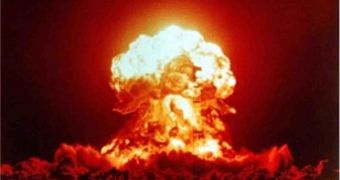Nuclear weapons generate high explosive energies by either fusing or splitting certain chemical elements. A new type of nuclear explosive developed by the US Department of Defense, on the other hand, uses nuclear reactions in order to determine gamma-ray emissions carrying energies about one thousand times larger than that obtained with the help of chemical explosives. The problem is that some researchers believe that this exotic new weapon could quickly eliminate the distinction between conventional and nuclear weapons, and could possibly trigger yet another arms race.
"Such extraordinary energy density has the potential to revolutionize all aspects of warfare," according to the Department of Defense's Militarily Critical Technologies List.
Isomers are chemical elements that may exist in a high-energy state for long periods, such as hafnium for example. Hafnium-178m2 is an isomer of hafnium-178 with a half-life of 31 years, and decays to a low-energy state by slowly emitting gamma-rays. In July 1999, Carl Collins from the University of Texas revealed, for the first time, how hafnium-178m2 could be used as explosive by triggering a forced decay with the help of low-energy X-rays. The energy released by the hafnium isomer during the experiment was about 60 times that of the energy used to trigger the decay; however, theoretical calculations showed that, in fact, much more energy could be extracted.
Isomer decay
Just as the energy of the electrons inside an atom can be increased by simply forcing photon absorption, hafnium-178m2 can be brought into an explosive state by pumping energy into its nucleus with the help of high-energy photons. After the atom experiences a high-energy state, it will start to decay to a low-energy one, by emitting gamma-ray photons.
Originally, isomers were thought as a mean to store energy for long periods, however the Department of Defense saw an opportunity into studying an accelerated decay, and started experimenting with thorium and niobium. By bombarding tantalum with protons, DoD researchers succeeded in producing hafnium-178m2, even though only small amount of isomer could be created at a time.
For the time being, hafnium-178m2 is obtained by refining it from nuclear material waste, in amounts less than one ten-thousandth of a gram.
Extreme power
Anyway, in the near future larger amounts of hafnium isomer may be created in cheaper ways, such as bombarding ordinary hafnium with high-energy photons. According to SRS Technologies, gram quantities of hafnium-178m2 could be obtained through this process in less than five years.
Production cost will most likely reach that of enriched uranium, however hafnium-178m2 explosives could be used in just about any quantity, since it does not require a critical mass to maintain the chain nuclear reaction, as uranium does.
DoD researchers reckon that about one gram of hafnium isomer may be able to produce an energy equivalent to that released by 50 kilograms of TNT. Not only that small missiles could produce much more damage than conventional weapons, but also the gamma-ray emissions determined by the explosion would kill any living being in the surrounding area. Unlike nuclear weapons, isomer explosives would determine very little fallout, but they would disperse radioactive particles, which could act very similarly to a 'dirty' bomb.
Already thin line starts to blur
In the outcome of World War II, the US realized the potential danger posed by small nuclear weapons, such as the 'Davy Crockett' nuclear bazooka capable of delivering 18 tons of TNT explosive power, and stopped manufacturing them. These weapons would basically be on the line between nuclear and conventional weapons. They feared that in a potential war, military commanders equipped with such explosive devices, would most likely use a nuclear weapon opposed to a conventional one, although the obtained effect would be roughly identical.
Additionally, in 1994, the US took another step towards increasing the gap between nuclear weapons and conventional weapons, by passing the Spratt-Furse law to prevent the US Army from creating nuclear weapons smaller than five kilotons. The development of the isomer weapon is now endangering all these preventive steps took by the US, and if not stopped now, it may eventually lead to a new arms race.
"Many countries which will not have access to these weapons will produce nuclear weapons as a deterrent," says Andre Gsponer, Independent Scientific Research Institute director. "We should remember that less than six years intervened between the first scientific publications characterizing the phenomenon of fission and the first use of a nuclear weapon in 1945," cautions the Militarily Critical Technologies List. The DoD, on the other hand, believes that technical issues may delay the use of isomers into useful applications for at least a decade or so.

 14 DAY TRIAL //
14 DAY TRIAL //